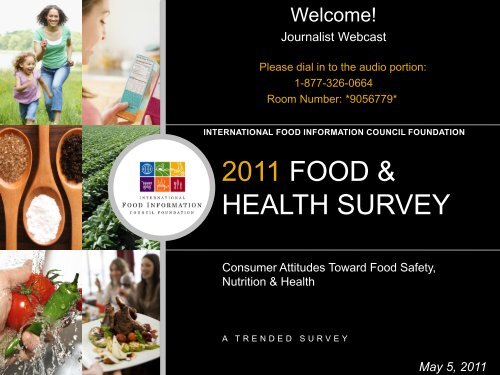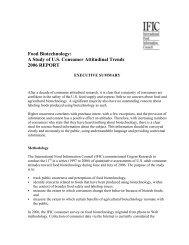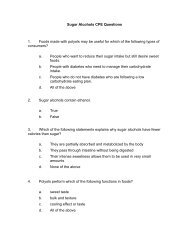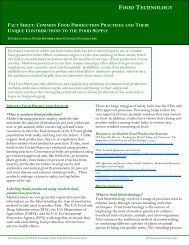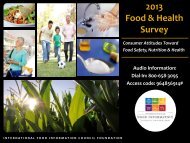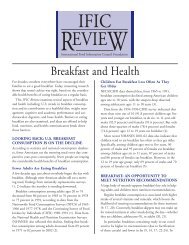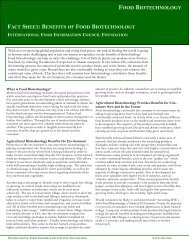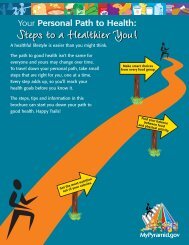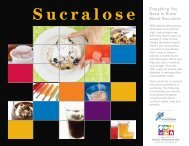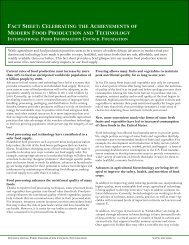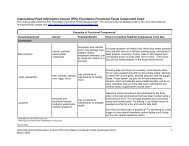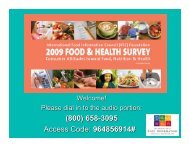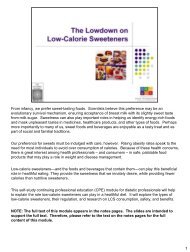2011 food & health survey - International Food Information Council ...
2011 food & health survey - International Food Information Council ...
2011 food & health survey - International Food Information Council ...
You also want an ePaper? Increase the reach of your titles
YUMPU automatically turns print PDFs into web optimized ePapers that Google loves.
Welcome!<br />
Journalist Webcast<br />
Please dial in to the audio portion:<br />
1-877-326-0664<br />
Room Number: *9056779*<br />
INTERNATIONAL FOOD INFORMATION COUNCIL FOUNDATION<br />
<strong>2011</strong> FOOD &<br />
HEALTH SURVEY<br />
Consumer Attitudes Toward <strong>Food</strong> Safety,<br />
Nutrition & Health<br />
A T R E N D E D S U R V E Y<br />
May 5, <strong>2011</strong>
INTERNATIONAL FOOD INFORMATION COUNCIL FOUNDATION 2<br />
IFIC FOUNDATION<br />
2 0 1 1 F O O D & H E A L T H S U R V E Y<br />
Today’s Speakers<br />
• Moderator:<br />
– Eric Mittenthal<br />
Director, Media Relations<br />
• Presentation of the Findings:<br />
– Carrie Dooher<br />
Director, Trends & Consumer Insights<br />
– Marianne Smith Edge, MS, RD, LD, FADA<br />
Senior Vice President, <strong>Food</strong> Safety<br />
and Nutrition
INTERNATIONAL FOOD INFORMATION COUNCIL FOUNDATION 3<br />
IFIC FOUNDATION<br />
2 0 1 1 F O O D & H E A L T H S U R V E Y<br />
Today’s Discussion<br />
• Brief Background and Trends<br />
• Presentation of Key Findings<br />
• Summary & Takeaways<br />
• Questions and Answers
IFIC FOUNDATION<br />
2 0 1 1 F O O D & H E A L T H S U R V E Y<br />
Mission:<br />
<strong>International</strong> <strong>Food</strong> <strong>Information</strong><br />
<strong>Council</strong> Foundation<br />
To effectively communicate science-based<br />
information on <strong>health</strong>, nutrition, and <strong>food</strong><br />
safety for the public good.<br />
Primarily supported by the broad-based <strong>food</strong>,<br />
beverage and agricultural industries.<br />
http://www.<strong>food</strong>insight.org<br />
INTERNATIONAL FOOD INFORMATION COUNCIL FOUNDATION 4
INTERNATIONAL FOOD INFORMATION COUNCIL FOUNDATION 5<br />
IFIC FOUNDATION<br />
2 0 1 1 F O O D & H E A L T H S U R V E Y<br />
The IFIC Foundation <strong>Food</strong> & Health Survey<br />
2006<br />
2007<br />
2008<br />
2009<br />
http://www.<strong>food</strong>insight.org<br />
2010
“It Is All About <strong>Food</strong>”<br />
6
IFIC FOUNDATION<br />
2 0 1 1 F O O D & H E A L T H S U R V E Y<br />
Broad Takeaways<br />
• Consumers are increasingly concerned about<br />
the price of their <strong>food</strong>.<br />
• While consumers say they are <strong>health</strong>ier, they<br />
are making fewer dietary changes and are<br />
less physically active.<br />
• Consumers continue to be confused about<br />
the role calories play in their diet.<br />
• Consumers want to know what to eat rather<br />
than what not to eat.<br />
INTERNATIONAL FOOD INFORMATION COUNCIL FOUNDATION 7
Methodology<br />
8<br />
Methodology<br />
Web Survey<br />
Conducted By<br />
Population*<br />
Cogent Research (Cambridge, MA)<br />
Representative Sample of U.S. Adult Population (18+)<br />
on Age, Socioeconomic Profile, Race/Ethnicity, Region,<br />
and Gender<br />
Data Collection Period March 28-April 10, <strong>2011</strong><br />
Sample Size (Error)<br />
n=1,000<br />
(+ 3.10 for <strong>2011</strong>)<br />
(+ 4.3 among <strong>2011</strong>, 2010, 2009, 2008, 2007, 2006)<br />
*Weighting is a widely accepted statistical technique that is used to ensure that the distribution of the sample<br />
reflects that of the population on key demographics. With any data collection method, even when the<br />
outgoing sample is balanced to the Census, some populations are more likely than others to respond.<br />
NOTES:<br />
1) Statistical significant differences from previous years are noted in the report with up or down arrow keys:<br />
/ Significant increase/decrease from year indicated.<br />
2) Top 2 refers to the top two answers, 4 or 5 on a 5-point scale; Bottom 2 refers to the bottom two answers<br />
1 or 2 on a 5-point scale.<br />
3) Rounding: Due to rounding conventions, please note that Top 2 and Bottom 2 may not add to 100% or<br />
respective composite score. In addition, statistical comparisons and totals on charts may not add to<br />
100%. The discrepancy should be no more than +/- 1%.<br />
INTERNATIONAL FOOD INFORMATION COUNCIL FOUNDATION 8
INTERNATIONAL FOOD INFORMATION COUNCIL FOUNDATION 9<br />
IFIC FOUNDATION<br />
2 0 1 1 F O O D & H E A L T H S U R V E Y<br />
Purchasing Decisions
IFIC FOUNDATION<br />
2 0 1 1 F O O D & H E A L T H S U R V E Y<br />
Factors Influencing Purchasing Decision<br />
Taste continues to be the main driver of purchasing <strong>food</strong>s and beverages, but price has continued to rise as a<br />
significant factor, followed by <strong>health</strong>fulness and convenience. Sustainability, added in <strong>2011</strong>, is important to<br />
about half of Americans.<br />
Taste<br />
87%<br />
Price<br />
79%<br />
‟06- „10<br />
Healthfulness<br />
66%<br />
‟06, „09, „10<br />
Convenience<br />
58%<br />
„07, „09<br />
Sustainability<br />
52%<br />
An Impact (Top 2)<br />
How much of an impact do the following have on your decision to buy <strong>food</strong>s and beverages*<br />
[Scale: 1= “No impact at all” 5=“A great impact”] (n=1000)<br />
*Question asked since 2006.<br />
** Sustainability added in <strong>2011</strong>.<br />
/ Significant increase/decrease from year indicated<br />
INTERNATIONAL FOOD INFORMATION COUNCIL FOUNDATION 10
IFIC FOUNDATION<br />
2 0 1 1 F O O D & H E A L T H S U R V E Y<br />
Price Approaches Taste as Top Influencer<br />
for Americans<br />
100%<br />
95%<br />
90%<br />
85%<br />
85%<br />
88%<br />
84%<br />
87%<br />
86% 87%<br />
80%<br />
75%<br />
70%<br />
72%<br />
70%<br />
74%<br />
73%<br />
79%<br />
Taste<br />
Price<br />
65%<br />
65%<br />
60%<br />
55%<br />
50%<br />
2006 2007 2008 2009 2010 <strong>2011</strong><br />
How much of an impact do the following have on your decision to buy <strong>food</strong>s and beverages*<br />
[Scale: 1= “No impact at all” 5=“A great impact”] (n=1000)<br />
INTERNATIONAL FOOD INFORMATION COUNCIL FOUNDATION 11
INTERNATIONAL FOOD INFORMATION COUNCIL FOUNDATION 12<br />
IFIC FOUNDATION<br />
2 0 1 1 F O O D & H E A L T H S U R V E Y<br />
Restaurant Ordering Considerations<br />
Taste and price are the most important factors for Americans when deciding what to order in a restaurant.<br />
Taste<br />
69%<br />
Price<br />
61%<br />
Overall <strong>health</strong>fulness<br />
29%<br />
Calories<br />
20%<br />
Important: Ranked 1 or 2<br />
Appearance<br />
15%<br />
Convenience<br />
7%<br />
When deciding what item to order in a restaurant, how important is each of the following factors*<br />
[Please rank the factors where “1” is the most important]. (n=1000)<br />
*Question added in <strong>2011</strong>.
INTERNATIONAL FOOD INFORMATION COUNCIL FOUNDATION 13<br />
IFIC FOUNDATION<br />
2 0 1 1 F O O D & H E A L T H S U R V E Y<br />
Influencers of Healthful Choices During<br />
<strong>Food</strong> Shopping<br />
Unaided, one in four Americans mention “lower prices” as the key driver in helping them make <strong>health</strong>ful<br />
choices while shopping for <strong>food</strong>.<br />
Lower prices<br />
More information/better organization<br />
More choices/better quality<br />
Minimize un<strong>health</strong>y<br />
Healthier meals/taste better<br />
Don't need help/already easy<br />
Willpower/commitment to <strong>health</strong><br />
Eat before I go shopping<br />
Government<br />
Nothing/None/Don't know/N/A<br />
26% ‟10<br />
21% ‟10<br />
16%<br />
7% ‟10<br />
5%<br />
3%<br />
3%<br />
1%<br />
1% ‟10<br />
24%<br />
What would make it easier for you to make more <strong>health</strong>ful choices where you go <strong>food</strong> shopping* [Open-end] (n=1000)<br />
*Question added in 2010.<br />
/ Significant increase/decrease from year indicated
INTERNATIONAL FOOD INFORMATION COUNCIL FOUNDATION 14<br />
IFIC FOUNDATION<br />
2 0 1 1 F O O D & H E A L T H S U R V E Y<br />
Diet & Health
INTERNATIONAL FOOD INFORMATION COUNCIL FOUNDATION 15<br />
IFIC FOUNDATION<br />
2 0 1 1 F O O D & H E A L T H S U R V E Y<br />
Perceptions of Health Status<br />
Americans’ perceptions of their <strong>health</strong> status remains relatively stable. Although still small, the percentage of<br />
those rating their diet as “poor” has increased significantly in <strong>2011</strong>.<br />
Excellent Poor<br />
8% 5%<br />
‟07-‟10<br />
77% say<br />
<strong>health</strong> is at<br />
least “good”<br />
Very good<br />
28%<br />
Fair<br />
18%<br />
Good<br />
41%<br />
Which of the following best describes your overall <strong>health</strong> status* [Select one] (n=1000)<br />
*Question asked since 2006.<br />
/ Significant increase/decrease from year indicated
IFIC FOUNDATION<br />
2 0 1 1 F O O D & H E A L T H S U R V E Y<br />
Perceptions of Diet<br />
Compared to previous years, more Americans perceive their overall diet as being <strong>health</strong>ful (“extremely” or<br />
“somewhat”), with about half saying their diet is at least “somewhat <strong>health</strong>ful.”<br />
Not at all<br />
<strong>health</strong>ful<br />
Extremely <strong>health</strong>ful<br />
2% Not very <strong>health</strong>ful<br />
10%<br />
12%<br />
‟07-‟10<br />
‟06-‟10<br />
Somewhat <strong>health</strong>ful<br />
53%<br />
‟06, „10<br />
Neither <strong>health</strong>ful<br />
nor un<strong>health</strong>ful<br />
24%<br />
*Question asked since 2006 .<br />
How would you rate the <strong>health</strong>fulness of your overall diet Again, by “diet” we mean everything you<br />
consume, including <strong>food</strong>s; beverages; and vitamin, mineral, and other dietary supplements.*<br />
[Select one] (n=1000)<br />
/ Significant increase/decrease from year indicated<br />
INTERNATIONAL FOOD INFORMATION COUNCIL FOUNDATION 16
INTERNATIONAL FOOD INFORMATION COUNCIL FOUNDATION 17<br />
IFIC FOUNDATION<br />
2 0 1 1 F O O D & H E A L T H S U R V E Y<br />
Prevalence of Dietary Changes<br />
The majority of Americans state they are making changes in their diet. However, the actual number of Americans<br />
making changes has significantly decreased from 2010.<br />
Yes<br />
59%<br />
‟07-‟10<br />
No<br />
41%<br />
‟07-‟10<br />
Over the past six months, have you made any changes in an effort to improve the <strong>health</strong>fulness of your diet*<br />
[Select one] (n=1000)<br />
*Question asked since 2006.<br />
/ Significant increase/decrease from year indicated
INTERNATIONAL FOOD INFORMATION COUNCIL FOUNDATION 18<br />
IFIC FOUNDATION<br />
2 0 1 1 F O O D & H E A L T H S U R V E Y<br />
Body Mass Index (BMI)*<br />
Similar to CDC ranges, 30% of respondents are in the obese range, 32% are in the overweight<br />
range, 35% are in the normal range, and only 3% are in the underweight range.<br />
‟06,<br />
‟07,‟10 ‟07,‟08 ‟08<br />
BMI<br />
Calculation*<br />
3%<br />
35%<br />
32%<br />
30%<br />
CDC 2008<br />
1%<br />
32%<br />
34%<br />
34%<br />
Underweight<br />
INTERNATIONAL FOOD INFORMATION COUNCIL FOUNDATION 19<br />
IFIC FOUNDATION<br />
2 0 1 1 F O O D & H E A L T H S U R V E Y<br />
Weight Perception<br />
A majority of Americans continue to see themselves as overweight or obese.<br />
4% 38% 50% 8%<br />
Underweight<br />
INTERNATIONAL FOOD INFORMATION COUNCIL FOUNDATION 20<br />
IFIC FOUNDATION<br />
2 0 1 1 F O O D & H E A L T H S U R V E Y<br />
Current Weight Management Strategy<br />
Significantly fewer Americans report trying to lose weight and significantly more report trying to maintain<br />
weight. In addition, more Americans report they are not doing anything regarding their weight than in previous<br />
years.<br />
I am currently not<br />
doing anything<br />
regarding my<br />
weight<br />
I am trying to gain<br />
weight<br />
5%<br />
‟07<br />
I am trying to lose<br />
26% weight<br />
74%<br />
‟07-‟10<br />
43%<br />
‟07-‟10<br />
‟10<br />
of Americans<br />
are doing<br />
something<br />
with regard<br />
to their weight<br />
I am<br />
trying to<br />
maintain my<br />
weight<br />
26%<br />
‟08<br />
Which of the following best describes what you are currently doing regarding your weight*<br />
[Select one] (n=1000)<br />
*Question asked since 2007.<br />
/ Significant increase/decrease from year indicated
INTERNATIONAL FOOD INFORMATION COUNCIL FOUNDATION 21<br />
IFIC FOUNDATION<br />
2 0 1 1 F O O D & H E A L T H S U R V E Y<br />
Knowledge of Calories Per Day<br />
When asked to estimate the number of calories that should be consumed in an average day, one-third of<br />
Americans are unaware or unable to provide a response. Only one in ten estimate correctly; over half provide a<br />
response but estimate incorrectly.<br />
Over-estimated<br />
10%<br />
Unaware<br />
37%<br />
54%<br />
„07-‟10<br />
Responded but<br />
estimated<br />
incorrectly<br />
Estimated<br />
correctly<br />
9%<br />
Under-estimated<br />
44%<br />
‟10<br />
As far as you know, how many calories should a person of your age, weight, height, and physical<br />
activity consume per day* [Open-end] (n=1000)<br />
*Question asked since 2006. Estimate correctly is determined within a +/- 100 calorie range based on the MyPyramid formula.<br />
** Modification in 2008 to 2010: “And physical activity” was added to the question. Definitions of physical activity levels were<br />
provided.<br />
/ Significant increase/decrease from year indicated
IFIC FOUNDATION<br />
2 0 1 1 F O O D & H E A L T H S U R V E Y<br />
22<br />
Perceived Physical Activity Level<br />
Despite that over half of Americans are active, less than one in ten Americans say they are vigorously active.<br />
Nearly as many Americans say they are sedentary as those who say they are moderately active.<br />
Vigorously Active<br />
8%<br />
57% ‟10<br />
of Americans are<br />
active<br />
Sedentary<br />
43%<br />
‟10<br />
Moderately Active<br />
49%<br />
‟10<br />
On average, which of the following best describes your level of physical activity [Select one] * (n=1000)<br />
*Question added in 2010.<br />
** Definitions for each activity level was adapted using HHS guidelines and was defined as follows: Sedentary (A lifestyle that includes only the<br />
light physical activity associated with typical day-to-day life); Moderately Active (Typical lifestyle activities PLUS moderate physical activity such<br />
as brisk walking, slow biking, golfing, etc.); Vigorously Active (Typical lifestyle activities PLUS vigorous activity such as running, tennis, fast biking,<br />
etc.).<br />
/ Significant increase/decrease from year indicated<br />
INTERNATIONAL FOOD INFORMATION COUNCIL FOUNDATION 22
IFIC FOUNDATION<br />
2 0 1 1 F O O D & H E A L T H S U R V E Y<br />
Estimated Daily Calories Consumed vs.<br />
Burned<br />
Many Americans do not know how many calories they consume or how many they burn each day. Americans appear<br />
to be more confused regarding how many calories they burn. Among those who believe they know either or both,<br />
Americans estimate they consume more calories than they burn.<br />
And how many calories would you say you consumed yesterday* [Open-end] (n=1000)<br />
On average, how many calories do you think you “burn”/use per day [Open-end] (n=1000)<br />
*Question changed in <strong>2011</strong> from: “Now, on average, how many calories do you think you actually consume per day”<br />
** Outliers: Responses of 5000 or more have been excluded.<br />
/ Significant increase/decrease from year indicated<br />
INTERNATIONAL FOOD INFORMATION COUNCIL FOUNDATION 23
INTERNATIONAL FOOD INFORMATION COUNCIL FOUNDATION 24<br />
IFIC FOUNDATION<br />
2 0 1 1 F O O D & H E A L T H S U R V E Y<br />
<strong>Information</strong> Sources
IFIC FOUNDATION<br />
2 0 1 1 F O O D & H E A L T H S U R V E Y<br />
Familiarity with “Dietary Guidelines<br />
for Americans”<br />
Eight in ten Americans say they have heard at least something about the Dietary Guidelines for Americans.<br />
I know a fair<br />
amount about<br />
them<br />
27%<br />
‟09, „10<br />
I know a lot about<br />
them<br />
5% „10<br />
I have never heard<br />
of them<br />
19%<br />
‟09, „10<br />
I have heard of<br />
them, but know<br />
very little about<br />
them<br />
49%<br />
Which of the following best describes your familiarity with the “Dietary Guidelines for Americans,” which are the<br />
US government-approved, <strong>food</strong> and nutrition guidelines* [Select one] (n=1000)<br />
*Question added in 2009.<br />
/ Significant increase/decrease from year indicated<br />
INTERNATIONAL FOOD INFORMATION COUNCIL FOUNDATION 25
INTERNATIONAL FOOD INFORMATION COUNCIL FOUNDATION 26<br />
IFIC FOUNDATION<br />
2 0 1 1 F O O D & H E A L T H S U R V E Y<br />
Awareness of Educational Programs<br />
Very few Americans say they can name any specific program aside from MyPyramid and the Dietary Guidelines<br />
that provide information focused on helping families learn about <strong>health</strong>y living.<br />
No<br />
95%<br />
Yes<br />
5%<br />
Aside from the MyPyramid and the “Dietary Guidelines for Americans,” are you familiar with any other initiatives from<br />
government, nonprofits, or corporations focused on helping families learn about <strong>health</strong>y living* [Select one] (n=1000)<br />
*Question added in <strong>2011</strong>.
INTERNATIONAL FOOD INFORMATION COUNCIL FOUNDATION 27<br />
IFIC FOUNDATION<br />
2 0 1 1 F O O D & H E A L T H S U R V E Y<br />
Concern with Amount of Sodium<br />
There has been no change since 2010 in Americans’ concern about the amount of sodium in their diet;<br />
about half of Americans are concerned.<br />
Extremely<br />
concerned<br />
18%<br />
Not at all<br />
concerned<br />
11%<br />
53% of Americans are<br />
concerned about the<br />
amount of sodium<br />
consumed<br />
Not very<br />
concerned<br />
13%<br />
Somewhat<br />
concerned<br />
35%<br />
Neither concerned<br />
nor unconcerned<br />
23%<br />
How concerned are you, if at all, with the amount of sodium in your diet* [Select one] (n=1000)<br />
*Question added in 2010.
INTERNATIONAL FOOD INFORMATION COUNCIL FOUNDATION 28<br />
IFIC FOUNDATION<br />
2 0 1 1 F O O D & H E A L T H S U R V E Y<br />
<strong>Food</strong> Safety
IFIC FOUNDATION<br />
2 0 1 1 F O O D & H E A L T H S U R V E Y<br />
<strong>Food</strong> Safety Confidence<br />
About half of Americans are confident in the safety of the U.S. <strong>food</strong> supply.<br />
Extremely<br />
confident<br />
12%<br />
‟08, „10<br />
Not at all<br />
confident<br />
5%<br />
Not very confident<br />
14%<br />
„08, ‟09<br />
50% ‟08<br />
of Americans are<br />
confident about the safety<br />
of the US <strong>food</strong> supply<br />
Somewhat<br />
confident<br />
39%<br />
Neither confident<br />
nor unconfident<br />
31%<br />
‟09<br />
To what extent, if at all, are you confident in the safety of the U.S. <strong>food</strong> supply* [Select one] (n=1000)<br />
*Question asked since 2008.<br />
** Due to rounding, chart does not equal 100%.<br />
/ Significant increase/decrease from year indicated<br />
INTERNATIONAL FOOD INFORMATION COUNCIL FOUNDATION 29
INTERNATIONAL FOOD INFORMATION COUNCIL FOUNDATION 30<br />
IFIC FOUNDATION<br />
2 0 1 1 F O O D & H E A L T H S U R V E Y<br />
Safety of Imported <strong>Food</strong>s<br />
More than half of Americans say they do not believe imported <strong>food</strong>s are as safe as <strong>food</strong>s produced or grown in<br />
the USA.<br />
As safe as <strong>food</strong>s<br />
produced or<br />
grown in the USA<br />
34%<br />
More safe than<br />
<strong>food</strong>s produced or<br />
grown in the USA<br />
5%<br />
Less safe than<br />
<strong>food</strong>s produced or<br />
grown in the USA<br />
61%<br />
*Question added in <strong>2011</strong>.<br />
In general, do you think that imported <strong>food</strong>s are…* [Select one] (n=1000)
IFIC FOUNDATION<br />
2 0 1 1 F O O D & H E A L T H S U R V E Y<br />
General <strong>Food</strong> Safety Practices<br />
Across most actions asked about, fewer Americans report performing <strong>food</strong> safety practices on a regular basis<br />
compared to previous years.<br />
Wash my hands with soap and water<br />
Wash cutting board(s) with soap and water or<br />
bleach<br />
79% „08-„10<br />
71% „08-„10<br />
Cook to required temperature<br />
(such as 165°F for poultry)<br />
Properly store leftovers within 2 hours of serving<br />
68%<br />
68%<br />
„08<br />
„08<br />
Separate raw meat, poultry and sea<strong>food</strong> from<br />
ready-to-eat <strong>food</strong> products<br />
62%<br />
„08<br />
Use different or freshly-cleaned cutting boards for<br />
each product (such as raw meat or poultry or…<br />
51%<br />
Use a <strong>food</strong> thermometer to check the doneness of<br />
meat and poultry items<br />
None of the above<br />
8% ‟08-„10<br />
29%<br />
„09<br />
Which of the following actions do you perform regularly when cooking, preparing, and consuming <strong>food</strong> products*<br />
[Select all that apply] (n=1000)<br />
*Question asked since 2008.<br />
/ Significant increase/decrease from year indicated<br />
INTERNATIONAL FOOD INFORMATION COUNCIL FOUNDATION 31
IFIC FOUNDATION<br />
2 0 1 1 F O O D & H E A L T H S U R V E Y<br />
Sources of <strong>Food</strong> <strong>Information</strong><br />
Americans most often cite the nutrition facts panel as the primary source for <strong>food</strong> and nutrition information.<br />
However, when media sources are considered together, two-thirds of Americans look to media sources for <strong>food</strong><br />
and nutrition information.<br />
What three sources of information do you use most often to guide your <strong>food</strong> and nutrition practices* [Select three] (n=1000)<br />
*Question changed in <strong>2011</strong>.<br />
Internet article 19%<br />
Cooking shows/hosts 18%<br />
TV or radio news program 18%<br />
Magazine article 17%<br />
Newspaper 10%<br />
Talk shows 7%<br />
Public service announcement or ad campaign on TV or radio 4%<br />
Blog or social networking site (e.g., Twitter, Facebook, etc) 3%<br />
<strong>Food</strong> label 59%<br />
Friends/family 38%<br />
Medical professional (e.g., doctor, nurse, physician assistant, pharmacist, etc) 28%<br />
Grocery store, drug store, or specialty store 28%<br />
Health association 11%<br />
Registered dietitian 9%<br />
Product or manufacturer communications (i.e., Web sites, advertising, etc) 8%<br />
Government official/agency 4%<br />
At/from schools 3%<br />
Church/faith based group 3%<br />
Consumer advocacy groups 3%<br />
Cooperative extension service agent 2%<br />
Community leader 1%<br />
Livestock veterinarian 1%<br />
Other 6%<br />
68%<br />
cite at<br />
least<br />
one<br />
media<br />
source<br />
INTERNATIONAL FOOD INFORMATION COUNCIL FOUNDATION 32
IFIC FOUNDATION<br />
2 0 1 1 F O O D & H E A L T H S U R V E Y<br />
Consumer Messaging<br />
Over 60 percent of Americans would rather hear positive messages about what to eat, rather than negative<br />
messages regarding what not to eat.<br />
Strongly agree<br />
27%<br />
„09<br />
Strongly disagree<br />
6%<br />
„09 Somewhat<br />
disagree<br />
4%<br />
„09<br />
62% „09<br />
Agree<br />
Neither<br />
disagree<br />
nor agree<br />
28%<br />
Somewhat<br />
agree<br />
36%<br />
To what extent do you agree or disagree with the following statements regarding <strong>food</strong> and <strong>health</strong> information I<br />
am more interested in hearing about what TO eat, rather than what NOT to eat * [Select one] (n=1000)<br />
*Question last asked in <strong>survey</strong> in 2009.<br />
** Due to rounding, chart does not equal 100%.<br />
/ Significant increase/decrease from year indicated<br />
INTERNATIONAL FOOD INFORMATION COUNCIL FOUNDATION 33
INTERNATIONAL FOOD INFORMATION COUNCIL FOUNDATION 34<br />
IFIC FOUNDATION<br />
2 0 1 1 F O O D & H E A L T H S U R V E Y<br />
In Summary<br />
American consumers are using a more critical eye to<br />
evaluate their <strong>food</strong>. They are balancing not only taste,<br />
or <strong>health</strong>fulness, but also many factors such as what<br />
<strong>food</strong> is in their grocery carts, on their table, and in their<br />
body; where their <strong>food</strong> comes from; how it was<br />
produced; the safety and reliability of the U.S. <strong>food</strong><br />
supply; and <strong>food</strong>‟s overall <strong>health</strong>fulness.<br />
While taste remains important to Americans, based on<br />
the current environment, price and the economy are<br />
having more influence than over the past five years.
INTERNATIONAL FOOD INFORMATION COUNCIL FOUNDATION 35<br />
IFIC FOUNDATION<br />
2 0 1 1 F O O D & H E A L T H S U R V E Y<br />
Questions and Answers
INTERNATIONAL FOOD INFORMATION COUNCIL FOUNDATION 36<br />
IFIC FOUNDATION<br />
2 0 1 1 F O O D & H E A L T H S U R V E Y<br />
Resources for Journalists<br />
For Inquiries/Interviews with Experts:<br />
– Eric Mittenthal (mittenthal@ific.org)<br />
– Jania Matthews (matthews@ific.org)<br />
– Phone: 202.296.6540<br />
The Executive Summary & Media Resource<br />
Page is available at: www.<strong>food</strong>insight.org<br />
Twitter hashtag: #<strong>food</strong>insight


